You’ve likely needed to use lithium-ion batteries for at least one device at some point. They can be a pain to replace when they run out of juice, and though they typically last a long time, they don’t last forever. But a group of researchers at Carnegie Mellon University and Missouri University of Science and Technology have developed a method of 3D printing lithium-ion batteries which greatly improves their capacity and charge-discharge rates. The results are published in a paper entitled “3D printed hierarchically-porous microlattice electrode materials for exceptionally high specific capacity and areal capacity lithium ion batteries,” which you can access here.
It has already been possible to 3D print porous electrodes for lithium-ion batteries, but the design of the 3D printed electrodes is limited to just a few possible architectures. The capacity of lithium-ion batteries can be greatly improved by creating pores and channels at the microscale in the electrodes. The internal geometry that has produced the best porous electrodes through 3D printing is called interdigitated geometry, which involves metal prongs interlocked like clasped fingers, with lithium moving back and forth between both sides. This geometry is not optimal, however.
 The research team, led by Carnegie Mellon Associate Professor of Mechanical Engineering Rahul Panat, has developed a new method of 3D printing lithium-ion battery electrodes. Their method creates a 3D microlattice structure with controlled porosity.
The research team, led by Carnegie Mellon Associate Professor of Mechanical Engineering Rahul Panat, has developed a new method of 3D printing lithium-ion battery electrodes. Their method creates a 3D microlattice structure with controlled porosity.
“In the case of lithium-ion batteries, the electrodes with porous architectures can lead to higher charge capacities,” said Panat. “This is because such architectures allow the lithium to penetrate through the electrode volume leading to very high electrode utilization, and thereby higher energy storage capacity. In normal batteries, 30-50% of the total electrode volume is unutilized. Our method overcomes this issue by using 3-D printing where we create a microlattice electrode architecture that allows the efficient transport of lithium through the entire electrode, which also increases the battery charging rates.”
Panat and fellow author Mohammad Sadeq Saleh have been studying the 3D printing of microlattice structures for some time now, and used a method of Aerosol Jet 3D printing that they developed themselves to create the porous microlattice architectures for the battery electrodes. The microlattice structure (Ag) used for the batteries’ electrodes improved battery performance in several ways, including a fourfold increase in specific capacity and a twofold increase in areal capacity when compared to a solid block (Ag) electrode. The electrodes were also incredibly robust, retaining their 3D lattice structures after 40 electrochemical cycles. The batteries can, therefore, have high capacity for the same weight or the same capacity for a greatly reduced weight, which is important for transportation applications.
Before this, 3D printed batteries were created using extrusion-based 3D printing, which could create interdigitated structures but was not capable of fabricating the complex geometries that the research team’s Aerosol Jet method can manage. With their method, individual droplets can be quickly assembled one by one into 3D structures.
“Because these droplets are separated from each other, we can create these new complex geometries,” said Panat. “If this was a single stream of material, as is in the case of extrusion printing, we wouldn’t be able to make them. This is a new thing. I don’t believe anybody until now has used 3-D printing to create these kinds of complex structures.”
This method has many implications for consumer electronics, medical devices, and aerospace. The researchers believe that the technology will be able to be translated to industrial applications in two to three years.
Authors of the paper include Panat, Saleh, Jie Li and Jonghyun Park.
Discuss this and other 3D printing topics at 3DPrintBoard.com or share your thoughts below.
[Images: Rahul Panat]Subscribe to Our Email Newsletter
Stay up-to-date on all the latest news from the 3D printing industry and receive information and offers from third party vendors.
You May Also Like
Precision at the Microscale: UK Researchers Advance Medical Devices with BMF’s 3D Printing Tech
University of Nottingham researchers are using Boston Micro Fabrication‘s (BMF) 3D printing technology to develop medical devices that improve compatibility with human tissue. Funded by a UK grant, this project...
3D Printing Webinar and Event Roundup: April 21, 2024
It’s another busy week of webinars and events, starting with Hannover Messe in Germany and continuing with Metalcasting Congress, Chinaplas, TechBlick’s Innovation Festival, and more. Stratasys continues its advanced training...
3D Printing Webinar and Event Roundup: March 17, 2024
It’s another busy week of webinars and events, including SALMED 2024 and AM Forum in Berlin. Stratasys continues its in-person training and is offering two webinars, ASTM is holding a...
3D Printed Micro Antenna is 15% Smaller and 6X Lighter
Horizon Microtechnologies has achieved success in creating a high-frequency D-Band horn antenna through micro 3D printing. However, this achievement did not rely solely on 3D printing; it involved a combination...































